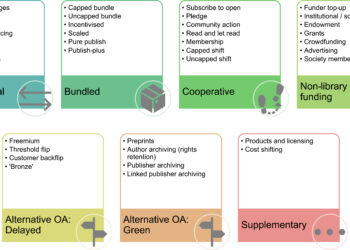
One of the truisms that often comes up when discussing Open Access (OA) business models is that the majority of OA journals do not charge authors an article processing charge (APC). This has been a standard talking point supported by multiple studies (most now a few years out of date), and by the continuing work of Walt Crawford. It’s a statement on hears over and over (a quick Google search provides mentions here, here, here, here, here, here, and here — if Wikipedia says it’s true, it must be, right?). It’s a factoid I myself have used in arguments. But is it really an accurate representation of the OA publishing market? A closer look suggests that by strictly limiting the definition of what qualifies as an “OA journal”, we may be missing out on what’s actually happening.
Crawford recently released his latest set of preliminary numbers (his work continues to be tremendously valuable in helping track and understand OA growth). Taking his strictest criteria, and limiting the analysis just to journals that have actually published an article in the last year, he gets the following results: for 2014, there were 8,760 OA journals, and publishing in 73% (6,395) of them was free for authors (no APC charged). The percentage of total OA articles in those journals was 43%.
This immediately offers up a caveat to the notion that most OA is published without author charges. Most journals in the study do not charge authors, but the majority of authors are choosing to publish in journals that do charge. 27% (2,365) of the journals studied required an APC and were responsible for 57% of the articles.
The journals in the study, however, do not represent the entire spectrum of OA journal publishing. As Crawford noted in a recent comment thread on this site, the pool of journals examined is limited to fully gold OA journals listed by the Directory of Open Access Journals (DOAJ). That means no hybrid journals or articles published OA in hybrid journals were counted.
The reason for this limitation is a practical one — there’s no easy way to measure the numbers of hybrid journals and articles, and there’s no easy way to track journals and articles not listed in the DOAJ. But this practical limitation also creates limitations on the conclusions that can be drawn.
Precise language is key to scientific understanding. As a former journal editor, the most common problem I had to correct from authors was a tendency toward language that overstated their conclusions — calling a cellular factor “necessary” for some action, rather than “sufficient” is a common example. Some of this was deliberate fuzziness borne out of wishful thinking in hopes of supporting a preconceived model, while the majority was unintentional and just poor choices of words.
To be precise then, stating that the majority of OA journals do not charge an APC is going beyond what the data tells us. What we can safely say is that the majority of fully gold OA journals listed by the DOAJ do not charge APCs, though they do not produce the majority of articles from that pool.
What about those hybrid journals and articles? Can they be summarily dismissed from the discussion, or are they worth a look?
To get a quick sense of the numbers I spent 20 minutes or so digging around some of the bigger publisher websites:
- Elsevier: 1,676 journals listed as having a hybrid OA option
- Wiley: 1,300 journals listed as having OA available, 33 listed in DOAJ so 1,277 titles can be counted
- Springer: “the majority of our 2000+ journals” offer an OA option, so at minimum 1,001 titles
- Taylor & Francis: hybrid OA available for over 1,600 journals
- Sage: 630 journals listed as having a hybrid option
- Oxford University Press: 250+ hybrid journals
- Cambridge University Press: “over 200” hybrid journals
That gives a total of at least 6,634 journals offering OA publication from just a quick sampling, leaving out many large publishers and a huge number of smaller university presses and independents. Add that to Crawford’s earlier totals and the conclusion is reversed: at least 58% (8,999) of journals that offer OA publishing do indeed charge an APC.*
If you spend much time in the world of altmetrics and DORA, it may be more forward-thinking to look at the world on an article level. We live in an article-level economy, and an individual article should be judged for its own merits, not averaged in with its neighbors.
Add in then the number of articles published by authors taking up the hybrid option and the total number of OA articles published with an APC increases even further into the majority. These numbers are hard to come by, but for OUP, they’ve been pretty steady for the last few years, ranging from 4% to 6% of total articles (5.01% for 2014). Our total numbers have increased due to the increasing number of journals and articles published each year.
So to more clearly state things:
- The majority of fully gold OA journals listed by the DOAJ do not charge authors an APC.
- The majority of journals offering OA publication to authors charge APCs.
- The majority of OA papers are published via paying an APC.
The distinctions are important here. When making business plans or setting policies, it is crucial to have an accurate picture of current publishing practices, and the clear picture here is that most OA publishing is done for a fee.
*My numbers still exclude fully gold OA journals not included in the DOAJ so the conclusions must include this caveat, but given the enormous number of questionable/predatory/deceptive journals that fall into this category and that certainly charge APCs, their inclusion would likely only push things further in the direction of APC required OA.
Discussion
25 Thoughts on "Is it True that Most Open Access Journals Do Not Charge an APC? Sort of. It Depends."
One of my articles listed by you so I got a ping. Nice article and I like your numbers. One comment and one question:
?- you wouldn’t have this broken down by field would you? I suspect some fields tend to be more ‘free’ than others.
Comment- to add another caveat to your model some publishers wave APC charges if you can not afford to pay them. In my field, Archaeology, all of the Gold Open Access journals do this- at least the ones that are not deceptive journals- Internet Archaeology, Ubiquity press, etc. STAR has an interesting system where if your are a member of its society it is free to publish in its Gold Open Access Journal. While there is an APC I suspect the majority of articles in that journal are not published through APCs. That is only one example but I have seen lots of interesting deals in which APCs are waived- some though are from shady publishers.
Also, the mega journals that get archaeology publications as well do this i.e. PLOS ONE. I believe PLOS ONE still charges ~90%(?) of their authors but they do waive charges for others.
Will that change your numbers dramatically? Not sure. It might push the DOAJ numbers below 50% or it might not. It could have a more profound effect in different fields. I think it will add a bit of wiggle room to your numbers.
There have been some studies that broke things down by field, such as this one from 2011:
http://crl.acrl.org/content/72/4/372.abstract
OA journals in the fields of biology and medicine are larger than the others, more likely to charge fees, and more likely to have a high citation impact.
Though to be fair, the landscape has changed quite a bit since 2011.
And you’re right that waivers complicates things further. I’m not sure I’d change the journals part of the numbers — either the journal charges an APC as its regular practice or it doesn’t, but it would affect the individual article numbers if the author had their fee waived. I don’t know of any journals that list their waiver numbers. At best, PLOS gives a total dollar figure, for 2013-2014 (anyone notice that PLOS is mighty late with their Progress Update this year?) which was $3,889,000 waived out of $48,956,000 in publishing fees (7.9%). But we don’t know how that translates into articles given that PLOS charges very different fees for its different journals.
Sorry, I was not clear. I think that:
‘The majority of fully gold OA journals listed by the DOAJ do not charge authors an APC.
The majority of journals offering OA publication to authors charge APCs.’
Still stands and would not want to split hairs about that. It was more for your last point-
‘The majority of OA papers are published via paying an APC.’
I suspect it might still hold even when waivers are counted. But I do wonder if waivers would change the numbers for papers or how much of a factor they are in publishing.
It’s a really good question. I have no real sense of how common waivers are across the market. I know that they used to be much easier to get, but have in recent years gone from a “no questions asked” policy at many journals to a complicated application process. I suspect the amount given varies widely from journal to journal, publisher to publisher.
What I’ve always objected to in the way this stat is used, is that DOAJ doesn’t differentiate between no author fee and a current 100% discount, which is how many OA journals are entering the market. To add to your point about accuracy of language, this statistic also has to be accurately applied. It leads to an easy conflation of a ‘current pricing plan snapshot’ with ‘long-term business model’. To take one example, eLife for instance has no fee to authors, but has always stated that this is what it intends to do – how it intends to become sustainable.
So the fact may stand that the majority of fully OA journals do not currently charge authors, but not that those journals in the broader sense run APC-free business models.
Taking a look at the DOAJ csv I’ve just downloaded, 15/66 Elsevier titles are listed as non-author charging, 11/16 OUP titles, 14/30 Wiley titles. I’ll eat my hat if they’re not, in the majority and in the mid-term, APC-modelled journals. There’s a big data quality issue if we use this stat to infer anything about the journals ecosystem other than a current snapshot of pricing.
Waiving all OA fees for the first few years is pretty standard practice for launching a new OA journal, to give it time to establish itself in the market before charging authors. If these journals with business models based on charging an APC are being counted as something different, then that further distorts the picture.
Can you give any examples of new OA launches offering 100% waivers. I can’t think of examples in physics.
Hi Claire,
As Walt notes in a comment below, he sees about 330 journals in DOAJ that don’t currently charge an APC but are likely to in the near future. Some examples I can point to would include PeerJ, which has gone through multiple periods of waiving all author fees as parts of campaigns to drum up submissions. Another would be this new journal, Environmental Epigenetics, from OUP, which as noted on this page, has chosen to waive all author fees for 2015 as the journal gets going:
http://eep.oxfordjournals.org/journal_policies.html#Open%20access
When we say the author does not pay the immediate question that comes to mind is who does pay? Does a granting agency pay, or does advertising cover the costs of publication? In short, I don’t think a Gold OA journal provides that ever elusive free lunch!
There are multiple ways to pay the bills. In the case of the journals we host, costs are shared between the library and the editor’s department. For some societies, costs are paid for through other revenue streams (advertising, dues, conferences, other professional development outlets, etc.) Raym Crow produced a report several years ago detailing options (http://www.sparc.arl.org/sites/default/files/incomemodels_v1.pdf). No one who thinks about this at even a surface level believes there are no costs even if authors aren’t charged.
That’s interesting, but I wonder which methods of funding are most common for these non-fee-charging OA journals. Charity, advertising dues and society memberships all seem fairly unreliable.
Here’s an example of what happens to one of those journals when the grant runs out:
http://www.mpg.de/9293322/living-reviews-springer
Even excluding hybrid journals, the vast majority of OA papers are published in very few journals. Using data from 2014 (Thomson Reuters), there were 184,180 research articles published in full OA journals (14% of total research article output), of which PLOS ONE published 29,778 (or about 16% of total). The top seven journals published over 25% of all OA papers and 81 journals published just over 50%. The vast majority of OA journals may levy no fees, but for the large part, most OA article publication takes place in journals that levy APCs.
See figure at: https://twitter.com/ScholarlyChickn/status/636540176634892290
Responding to several comments here.
1. Yes, there are more recent breakdowns of fee-vs.-pay on a subject level. See my blog (Walt at Random, http://walt.lishost.org) for partial figures for 28 topics; my forthcoming book will have figures for 98% (or so) of gold OA journals for those topics. The variation is, of course, HUGE.
2. Re definitions: I believe most people think of “OA journals” as gold OA journals and, of course, the article numbers are unknown.
3. As to no-fee journals from commercial publishers: a number of Elsevier and other such journals are explicitly sponsored by societies or universities, not trial runs. (As for trial runs: MDPI is fairly up front about waiving fees for the first year or two. In my current study of 9,700+ DOAJ journals, I find about 330 that seem to indicate that they may charge APCs in the future.
4. I’d guess that the money for most no-fee gold OA journals, especially in the global south where they predominate (94.4% of the more than 900 gold OA journals in Brazil are non-APC, for example), comes either from governments, universities and colleges, or associations/societies. It’s usually pretty explicit (esp. in SciELO and usually in OJS journals).
5. I’d argue with Phil D’s figures because Thomson Reuters only covers part of the field. I show at least 482,361 articles in gold OA journals for 2014, leaving out 20,000+ in journals I consider questionable and another 20,000+ in journals that don’t meet my criteria for OA. Phil’s number is less than half that. (I’m guessing the global South is badly underrepresented.)
6. I don’t believe there’s much disagreement that most OA articles appear in APC-charging journals–although that’s a segment thing: the vast majority of OA articles in the humanities and social sciences appear in journals that do NOT charge fees (about 76% in 2014), where the vast majority of biomed and STEM articles involve charges (about 63%).
Thanks for the clarifications Walt. Phil Davis has stated that his numbers come from Thomson-Reuters (https://twitter.com/ScholarlyChickn/status/636545179588141056) so like you, I suspect it’s only giving us a window into part of the market.
While for many who have been involved with OA for a long time, the definition of “open access” is long settled, but in practice, there are a remarkable number of different practices out there all labeled with that term. Journals that offer free availability but that use licenses more restrictive than CC BY are considered by many not to be “open access”. I’ve recently worked with a society whose “open access” program meant the author paid and the article was made freely available, yet the author still had to assign copyright to the society and it was published under traditional copyright. One can really define “open access” in a variety of ways, but in doing so, it does set particular limitations on what segment of the market one is then seeing (and I’ve been told the OSTP assiduously used the term “public access” to completely avoid any of these controversies).
On point 6, do you know the total number of HumSoc OA articles published last year as opposed to the number of STM articles? Curious to see the overall share of each.
Sure–with the usual caveat, that these are only articles in DOAJ-listed journals that I didn’t find reason to be skeptical of. I’m dividing the field into three segments, since biology and medicine seem to have a different nature than STEM. Given that:
Humanities and social sciences: 99,771 articles (in 4,037 journals of which 3,624 published articles in 2014)
STEM (NOT including PLOS One, which I’ve separated out as sui generis): 173,810 articles in 2,858 journals (of which 2,657 published articles in 2014) – noting that PLOS One adds another 31,882 articles.
Biomed: 176,898 articles in 2,616 journals, of which 2,478 published articles in 2014.
Oh: The biggest difference between biomed and STEM: APC levels. Biology and medicine absolutely dominate high-APC journals–e.g., for the top quadrant, 520 journals in biomed, 80 in STEM, 8 in HSS.
So if we include PLOS ONE (and BioMed in STM), then we’re looking at nearly a 4:1 ratio of Science versus HumSoc.
Close enough: 3.8 to 1. I wouldn’t be surprised if the ratio within subscription journal articles is that high, for that matter. (I have no idea, but I do know where the grant money is, and where lots of article publishing and very little monograph publishing is the order of the day…)
My experience is that HumSoc subscription prices are generally lower than STM journal prices. I was at a history meeting this summer where one historian noted that you could buy every single journal in the field along with a substantial number of poetry publications, all for less than the cost of one of the more expensive chemistry journals.
There is new paper titled “Fee Waivers for Open Access Journals” at
http://www.mdpi.com/2304-6775/3/3/155



